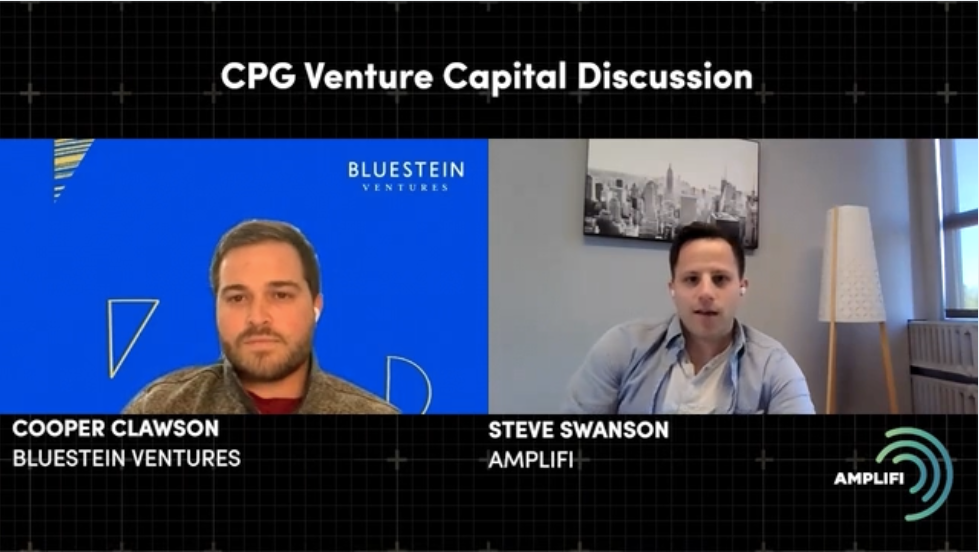Working With Venture Capital As a CPG Company in 2022
To gain insight into venture capital for CPG companies, we spoke with Cooper Clawson of Bluestein Ventures based out of Chicago. Bluestein specializes in high-growth consumer brands in between Seed to Series A stages and seeks innovative brands that are changing their respective industries.
Bluestein focuses heavily on brands in food tech and next-gen commerce, so for the sake of this article, we’ll be using these types of companies as examples. Food tech is a particularly interesting segment of the market right now, given the rapid growth of food tech lately. In 2020, investments in this industry doubled from 2019, reaching $2.3 billion. What’s there to learn from Bluestein’s experience with these special CPG companies? Watch the video below to learn more, or read on to learn how companies respond to market conditions and what venture capitalists look for in potential investments.
How market conditions influence investments
It’s no surprise that COVID severely impacted the performance across the board for CPG companies. While many companies struggled, others, specifically in food-tech, were primed for success. Ecommerce platforms and tech-driven food brands took off as consumers searched for new ways to shop in the unusual circumstances created by the pandemic.
Consider the grocery industry, which exploded during the beginning of the pandemic. Brands like InstaCart offered an innovative way for consumers to shop from the comfort of their homes. Big-name brands also had to adapt quickly to keep up, creating ways for their customers to shop online.
The enormous boost in eCommerce spending also gave consumers a greater ability to be more discerning with their purchases. The pandemic created more space for people to pick and choose products based on features such as quality of ingredients or amount of plastic usage in packaging. These trends appeal to a niche pocket of consumers that lets brands build up extremely loyal customer bases.
The takeaway here is that the market conditions over the past few years have required great adaptability from brands. Not all of these new brands will stick around, but it has put pressure on aspirational founders to recognize weak spots in the food industry and create change that betters the customer experience.
What venture capital firms are looking for
Well, we can speak for one firm at least. We’ll be drawing on our conversation with Cooper Clawson to relay some of the key items the team at Bluestein Ventures looks for when adding to their portfolio.
Tap into a niche market
Brands that know their market well are better positioned for growth. This is true for any company, but right now, these markets are easier to reach than ever before thanks to digital marketing. Brands that know how to access their target customers with content-driven commerce build loyal customers who are likely to refer the brand name to others. Even a small but dedicated audience is proof of potential—and reason for investment.
Provide the data—no matter how much you have
Founders who can give proof as to why their product or service is needed have a much better shot at raising capital. When that’s backed up by historical financials and a solid team, the case is only made stronger. And while young companies may not have a ton of data, you should still come prepared to a pitch with any data you have so far, just to give your potential investors a glimpse of how your plan has performed so far. This will provide proof that you’re being thoughtful about tracking your metrics right from the start.
Anticipate questions
Clawson noted that the best founders his company has met with have come prepared with lists of anticipated questions. Are there anomalies in your data? You should be ready to explain them. Venture capital firms will do their own research, and they’ll have access to your P&L sheets. With this in mind, be ready to explain your company’s performance thus far. Being able to explain discrepancies or dips in your P&L will indicate an understanding of your financials, which helps prove your business chops.
Create milestones—and the maps you’ll use to reach them
Venture capital firms will expect to see a path to your expected milestones—typically 12-18 months out. Not only will you need to chart where you’re going, but you’ll need to demonstrate how you’ll get there. Include distribution points, velocities, and work backward to show how you’ll hit your targeted goals. VC firms will appreciate this level of detail and thoughtfulness from founders, and you’ll be able to skip past some of the nitty-gritty questions firms usually have to go through during the sales process.
Do your due diligence
The advice we give so often to companies seeking outside capital: Do your due diligence. Understand the market conditions you’re in and what your company brings to the table. Know where you want to go, and how you’ll get there. The more you can back up your story with data, the better.
If you’re unsure of where to begin with your journey in mapping your way to a successful future, it might be worth talking to the team at AmpliFi, where you can gain access to a team of capital allocation experts and tech-driven solutions to help you navigate the complexities of finance.


